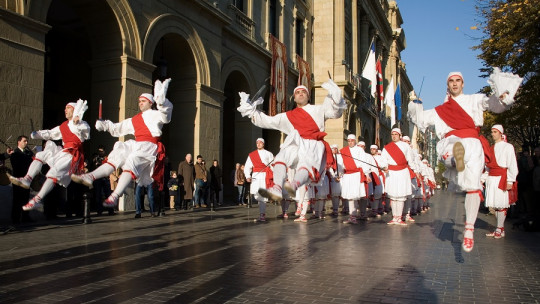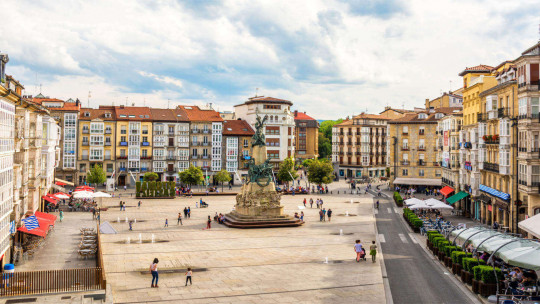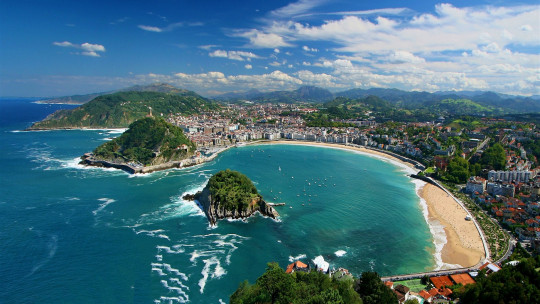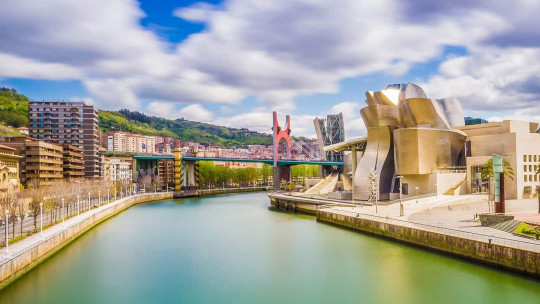The Basque Country is a land rich in culture and history, whose origins go back in time.
It is currently one of the most dynamic regions in Spain, both economically and culturally, full of very interesting traditions that will delight anyone who comes to know them.
From sports lovers to those in love with good gastronomy or good native folklore, everyone will enjoy a land that, day after day, continues to demonstrate that it still has a lot to say and a lot to offer.
Here we will see several of the most important Basque traditions briefly explained.
7 of the most important Basque traditions
In the following lines you will find Basque traditions classified into various categories.
1. Basque pelota
It is one of the best-known sports in the Basque Country and one of the most international Basque traditions The rule is simple: a pair of players or pelota players (or two pairs) stand in front of a fronton, against which they bounce a ball to obtain points.
It seems that the origin of the game has its roots in medieval Spain, when the so-called palm game, of French origin (Jeu de paumme), was played.
Ball games were very common among the European nobility , who had their own “frontons” in the courtyards of their palaces. From there it evolved until it became the different manifestations that we know today: Basque pelota, Valencian pelota and even tennis.
2. The Vitoria lantern procession
A beautiful and emotional celebration that brings together all Vitorians every August 4 at night, on the eve of the feast of the White Virgin, and that fills the capital with lights and colors.
The procession traces its origins to the 17th century when the chandlers of Vitoria met in a brotherhood sponsored by the White Virgin and established this procession in her honor.
The lanterns that fill the Vitorian night with light are related to divine mysteries. First the Joyful Mysteries parade, whose representative color is blue; later the Sorrowful Mysteries, with purple as a banner. The last to pass are the Glorious Mysteries, whose lanterns are flooded with red.
Each part of the procession follows the same structure Each group of Mysteries opens with the lantern/cross of the Lord’s Prayer, followed by the lanterns of the Ave Maria. Each part closes with a last lantern, which represents the Glory of the Father.
The procession ends on the steps of the Church of San Miguel and in the Plaza de la Virgen Blanca. It is undoubtedly one of the most mystical and emotional celebrations in the capital of Alava and one of the most beautiful processions in the Basque Country.
3. Basque dances
Basque culture is full of music and dance. There are innumerable popular manifestations in this sense, so we will limit ourselves to reviewing the best known ones.
The aurresku
One of the most famous and widespread dances, which has made Basque culture famous internationally. It is a contained and sober dance , of wonderful elegance, which plays with the positions of the feet and legs and the balance of the body. It is a very old traditional dance, usually used as a tribute and closely linked to solemn ceremonies such as weddings or official events.
The dancers dance to the beat of a very characteristic instrument, the txistu, and the drum. The txistu player is called txistulari, while the dancer is the aurreskulari.
Usually, the execution of the aurresku follows a defined scheme : First, the dancers circle the square a few times, and finally stop in front of the Town Hall. Next, the first of the dancers, the aurresku (front hand in Basque), performs his acrobatics.
The atzesku (back hand) or last dancer is the one who dances last. Usually, among their numbers there is one of special importance, the so-called Aurrez-aurre or Challenge, in which both dancers stand face to face and perform their dance steps, which are especially difficult.
There is also no shortage of invitations to the ball from the two most important ladies of the place, usually the mayor’s wife and another woman in his family. The aurresku performs an individual dance in front of the first, while the atzesku does the same later with the second guest lady.
Although originally the dance was choral, currently it is more common for the aurresku or front hand dancer to dance alone so the dance is known only by its name.
The Fandango and the Arin –Arin
They are the two most popular dances in Basque culture, present in all parties and celebrations Many experts relate them to the Spanish jota, due to its fast rhythm and vehement movements.
It seems that fandango arrived in northern Spain in the 18th century, from the south of the Peninsula. Considered at the time as an amoral and “sinful” dance, little by little it became established as one of the most beloved and popular dances in the Basque tradition. Its rhythm is ternary (that is, ¾), and generally consists of three steps, although in Navarra it is common to add a fourth.
The Arin-Arin shares many characteristics with the Fandango Its rhythm is also fast and the movements of the dancers are enthusiastic and passionate. Some specialists maintain that this type of dance may come from the so-called medieval high dances, which were characterized by dynamic and forceful steps. Its counterpart would be the Low Dances, whose evolutions were much more calm and solemn.
4. Carnivals
In the Basque tradition, Carnivals are lived with passion. These ancient celebrations still preserve certain pagan vestiges, and are most widespread in rural environments. One of the best known is the Zalduondo Carnival
The central figure of the Zalduondo Carnival is Markitos, a rag doll who is “accused” of all the ills of the community. The archaic origin of this tradition is obvious, since we must remember that Carnival served, in the Middle Ages, to give the people a few days of entertainment and relaxation before the arrival of Lent.
Poor Markitos is given a kind of public trial , and finally he is burned in the square so that with his “death” he purifies the sins of the community. In the past, his “death” was perpetrated with a shot to the head that blew up the doll.
Markitos is the king of the Zalduondo Carnivals, but There are many other rural carnivals in the Álava area such as those of Ilarduia, Salcedo, Kuartango… the main character varies depending on the locality: thus, for example, in Kuartango the party revolves around the Bear, while in the Ilarduia carnivals, the Straw Man is the prominent character.
Despite the differences, all these Basque carnivals They represent one of the most magnificent representations of what Carnival could have been like in medieval times when men and women let themselves be carried away by their appetites, and even caused the occasional disagreement.
5. The aizkolaris
These log-cutting competitions are very popular in the Basque tradition. They also have medieval (or perhaps much older) origins, when woodcutters challenged each other to see who could cut the most logs. However, official displays date back only to the 19th century
The aizkolari is the one who cuts the trunks (from aizkolari, person who handles an axe). He has to be in excellent physical condition, since cutting solid logs requires strength, precision and endurance. Although it has always been a male activity, currently quite a few women have dared to pick up the ax and participate in these competitions.
6. The hamlets
Typical construction of the Basque rural area, the origin of the farmhouse (baserri in Basque) dates back to the medieval centuries. Related to the Catalan Mas, it is an isolated building, surrounded by farmland and pasture, self-sufficient and capable of maintaining the needs of an entire family and its day laborers.
The construction is made of stone, with a gable roof. Stables, barns, etc. were usually found on the lower floor, while the first floor was used as the family home. Also as happened in Catalonia, It was the first-born male who usually inherited the estate, which caused quite a few conflicts and social problems since the second ones were left without a means of support.
The hamlet is the ultimate symbol of Basque rurality. Currently, many of them have been converted into tourist or restaurant farms, thus adapting to new times.
7. Gastronomy
Regarding the Basque traditions that have to do with gastronomy, the following stand out.
Vizcaina style cod
A quintessential dish of Basque cuisine, cod a la Vizcaina or Basque style is prepared with previously desalted cod and the famous Vizcaya sauce, whose main ingredients are garlic, onion and chorizo peppers. The result is a very tasty and not at all heavy dish that delights the table.
Perretxikos and snails of San Prudencio
Very typical of Vitoria for the festival of this saint, patron of the Álava region. Perretxitkos are the mushrooms par excellence of the Basque Country and Navarra ; They are served in a tasty sauce stirred with the snails, previously “scared” so that they come out of the shell.
The grilled steak
The meat of the north is enormously famous, and anyone who loves Basque cuisine should try the succulent and filling ribeye, well washed down with a good artisanal cider and crowned by the exquisite Basque cheese accompanied by walnuts.
Gipuzkoa cod omelette
The typical “cider menu”, characteristic of the Gipuzkoa area would be composed of this delicious omelette, grilled meats and fish and a good cider.
Drinks
We have already mentioned the typical cider, but we cannot forget the traditional txakolí from Vizcaya, usually white and made with green grapes, and the wines from Rioja Alavesa.









